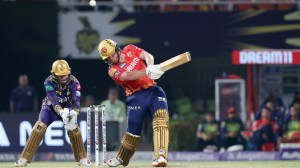- India
- International
Plan for 3 flyovers to ease Haji Ali junction gets traffic police nod
A study of commuter density by traffic cops shows Haji Ali junction the most congested road in south Mumbai.
 A traffic jam at Peddar road.
A traffic jam at Peddar road.
A fter conducting a commuter density survey at Haji Ali junction, the Mumbai Traffic Police have given their nod to a proposal for three flyovers to decongest the junction as recommended by Mumbai Transportation Support Unit (MTSU), a state government-think tank.
Results of the survey, according to which a whopping 40,000 vehicles pass through the junction every 60 minutes during peak hours, have prompted the traffic police to take immediate steps to ease congestion in the area.
A third lane towards Peddar Road has been opened up in the mornings and an extra lane on north-bound road in the evenings, so that heavy traffic can clear easily. Meanwhile, to ease the congestion further, the police have put the Haji Ali junction signal on “flasher” mode, so that the traffic of the south-bound road in the mornings and north-bound roads in the evenings can be allowed to pass on the instructions of the constable rather than signal timings.
The right turn near the Bridge Candy Hospital towards Haji Ali has also been closed in peak hours. “Even one vehicle taking a right turn from the hospital towards Peddar Road blocks the entire lane. Motorists will now have to take a U-turn from the Cadbury junction,” said Joint Commissioner of Police (Traffic) B K Upadhyay.
The police have also prohibited parking of vehicles on the south-bound lane in the mornings and on the north-bound lane in the evenings, as this has been observed to block traffic towards Orange Gate after the Eastern Freeway.

The MTSU had selected the design for the flyovers on July 9 in a meeting of the chief secretary-led empowered committee, comprising senior officials Maharashtra State Road Development Corporation (MSRDC), Brihanmumbai Municipal Corporation (BMC), the traffic police and members of the private sector. The proposal was conceived as an alternative to a decade-old proposal for a viaduct over Peddar Road, which is currently stalled due to various issues.
After the design was selected, the traffic police assigned a team to observe and take count of the number of vehicles passing through the Haji Ali junction and on Peddar road, an arterial north-south connector, for 15 days.
“The study was essential to planning and designing the Peddar Road flyover. We have found that over 70 per cent of the total 40,000 vehicles travel towards south Mumbai and only 20 to 30 percent vehicles take a left turn towards Breach Candy. “We have given a nod to the proposal as it was found feasible after we studied the commuter density,” Upadhyay said, adding that as per the study, the Haji Ali junction was the most congested road in south Mumbai.
Officials said that the architect appointed by the MTSU had proposed a plan for two south-bound flyovers with two lanes each, starting from the Lala Lajpatrai College at the Keshvrao Khade Road opposite Haji Ali. Two arms of the first flyover would be landing on Peddar Road and Breach Candy Road, while the remaining two arms of the second flyover would be landing at the Tardeo junction.
The north-bound flyover will stretch from Doctor House towards the Lala Lajpatrai College. Heavy vehicles would have to use the road under the flyovers which would ease traffic congestion, while motorists can zip through the viaduct.
While conducting the study, the police found that in order to solve traffic congestion problems of the city, they would have to take one road at a time starting with Peddar Road and P’Dmello Road as they are the most problematic in south Mumbai. “We have been conducting ‘Samwad’ sessions with the constables and trying to understand the traffic problems with each road across the city,” Upadhyay said.
megha.sood@expressindia.com
Apr 26: Latest News
- 01
- 02
- 03
- 04
- 05







































